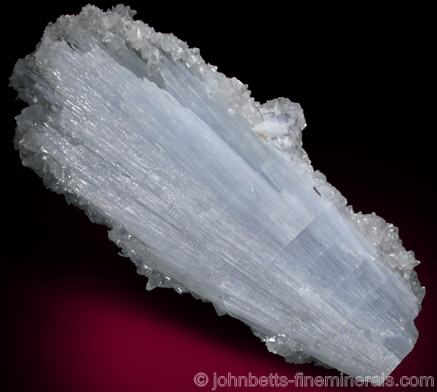The Mineral anhydrite

Anhydrite is not a common mineral, as it easily alters to the much more common mineral Gypsum from the addition of water into its chemical structure. Anhydrite and Gypsum are chemically similar, except Gypsum has the addition of water. In fact, the name of Anhydrite is derived from "An" and "Hydra" - meaning "without water" - in reference to its similarity to Gypsum but the fact that it lacks water. Some specimens only partly alter to Gypsum, leaving one part Anhydrite and the other part Gypsum. Many deposits that once contained much Anhydrite now contain an abundance of Gypsum which was formed by the alteration of the Anhydrite.
Anhydrite also exists as a relic of the past in several traprock occurrences, where the Anydrite dissolves and leaves a hollow cast around its original form. Epimorphs of Quartz and Prehnite over Anhydrite frequently form at certain localities, with the original Anhydrite totally replaced or dissolved.
Anhydrite sometimes occurs in arid regions, forming from the dehydration of Gypsum. Fine but usually small crystals may come from the rock area above salt domes, where the domes absorb all underground water and prevent it from entering the structure of the Anhydrite, which would otherwise cause it to alter to Gypsum. Anhydrite specimens in a collection may also alter to Gypsum if kept in moist conditions over a prolonged period of time.
Color
Colorless, white, yellow, gray, blue, orange-red, red, pink, purple.
Crystal System
Orthorhombic
Properties
Streak
White to light gray |
Hardness
3 - 3.5 |
Transparency
Transparent to translucent |
Specific Gravity
2.9 - 3.0 |
Luster
Vitreous to pearly |
Cleavage
2,3 - forming a cube |
Fracture
Uneven to splintery |
Tenacity
Brittle |
Other ID Marks
Many specimens are fluorescent. |
Uses
Anhydrite is used for the production of sulfuric acid and as a filler in paper. Good specimens of this mineral are rare and are desirable to collectors.
Noteworthy Localities
European occurrences include Altaussee, Styria, Austria; Leopoldshall, Stassfurt, Germany; and the Campiano Mine in Montieri, Tuscany, Italy. An interesting and famous locality of Anhydrite is the Simpleton Tunnel in Wallis, Switzerland, where it was found in white and lilac crystals during the construction of a railroad tunnel.
At Rio Grande Do Sul, Brazil, very large Quartz pseudomorphs after Anhydrite were found in long and flattened crystals. Some of the best Anhydrite on the mineral market is the light blue dense fibrous veins, some quite large in size, from the mines at Naica, Chihuahua, Mexico. In Canada, Anhydrite comes from Faraday in the Bancroft District, Hastings Co., Ontario.
In the U.S., Quartz, Amethyst and Prehnite pseudomorphs, as well as empty Anydrite casts, are plentiful at Paterson and Prospect Park, Passaic Co., New Jersey. Intact specimens, partially altered to white Gypsum, have also been found nearby at the Braen's in Haledon, Passaic Co., New Jersey. Other significant Anhydrite occurrences are Balmat, Essex Co., New York; Isle Royale, Houghton Co., Michigan; Ajo, Pima Co., Arizona; Bisbee, Cochise Co., Arizona; the Carlsbad District of Eddy Co., New Mexico; Death Valley, Inyo Co., California; and the salt domes of southern Louisiana.
Common Mineral Associations
Gypsum, Halite, Calcite, Brucite
Distingushing Similar Minerals
Calcite - Effervescent in hydrochloric acid.
Barite - Much heavier.